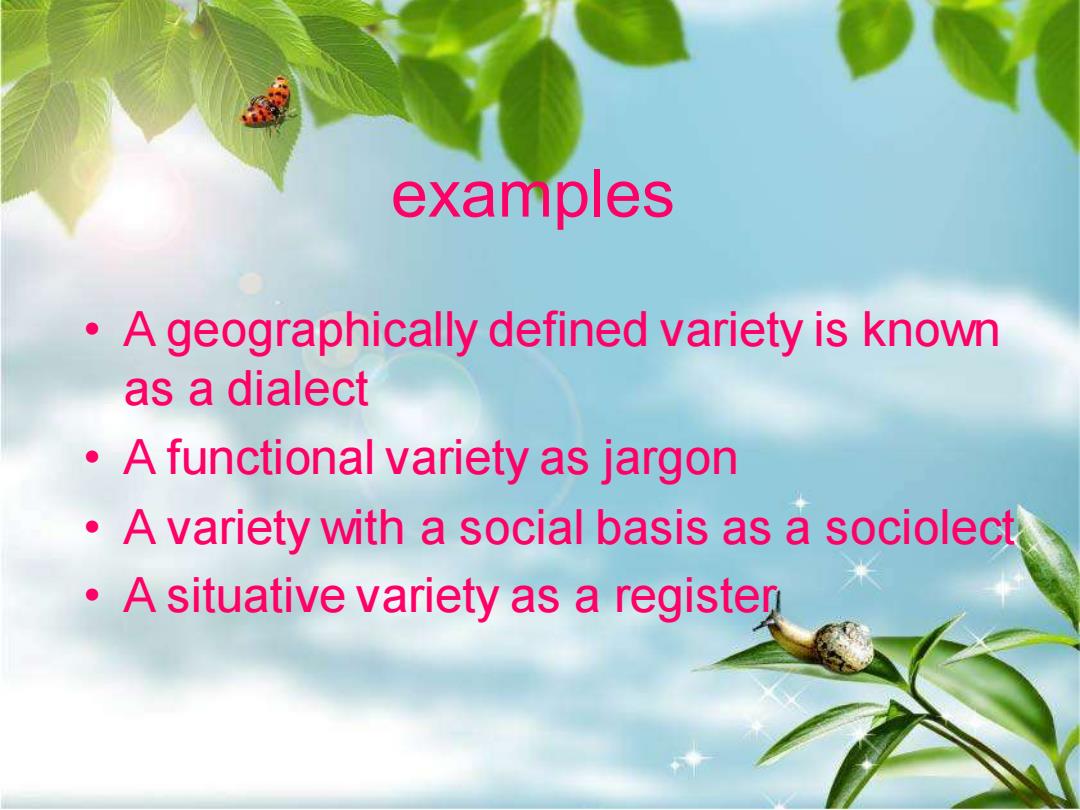
Chapter 7 Language and social culture Group3周荣兰蒋玉玲 汪永波 简永波王存林
Chapter 7 Language and social culture Group 3 周荣兰 蒋玉玲 汪永波 简永波 王存林

Language Varieties 语言多样性)上--outline 1.Language and society ● A.Language as a social activity ●】 B.The definition of sociolinguistics C.Relation between language and society with the help of examples 2.Dialect varieties ● A.Regional dialect ● B.Temporal dialect ● C.Sociolect/social dialect D.Standard dialect E.ldiolect
Language Varieties (语言多样性)-----outline • 1.Language and society • A.Language as a social activity • B.The definition of sociolinguistics • C.Relation between language and society with the help of examples • 2.Dialect varieties • A.Regional dialect • B.Temporal dialect • C.Sociolect/social dialect • D.Standard dialect • E.Idiolect

The understanding of Language Varieties Variety is a generic term for aparticular coherent form of language in which specific extralinguistic criteria can be used to define it as a variety. Language showing variation in space, time and social distance
The understanding of Language Varieties • Variety is a generic term for aparticular coherent form of language in which specific extralinguistic criteria can be used to define it as a variety. • Language showing variation in space, time and social distance

examples A geographically defined variety is known as a dialect A functional variety as jargon A variety with a social basis as a sociolect A situative variety as a register
examples • A geographically defined variety is known as a dialect • A functional variety as jargon • A variety with a social basis as a sociolect • A situative variety as a register

Language variety may include three terms ·Lingua franca(通用语) ·Pidgin(洋泾滨英语--混杂行话) ·Creole(克里奥尔语)
Language variety may include three terms • Lingua franca(通用语) • Pidgin(洋泾滨英语---混杂行话) • Creole(克里奥尔语)

Lingua franca(通用语) Lingua franca is the general term for a language that serves as a means of communication between different groups of speakers. Eg:English Putonghua
Lingua franca(通用语) • Lingua franca is the general term for a language that serves as a means of communication between different groups of speakers. • Eg:English ,Putonghua

Pidgin(洋泾滨英语--混杂行话) Pidgin refers to a contact language that arises in situations where speakers of different languages can not understand each other's first language or native language and,thus,need to develop a common means of communication . Eg:做了他/条子
Pidgin(洋泾滨英语---混杂行话) • Pidgin refers to a contact language that arises in situations where speakers of different languages can not understand each other’s first language or native language and ,thus,need to develop a common means of communication. • Eg :做了他 / 条子

Creole(克里奥尔语) Creoles are former pidgins whose functional and grammatical limitations and simplily simplification have been eliminated and which now function as full-fledged,standardized native languages ·克里奥尔语是混杂行话的前生,其功能和语法上 的局限性及简化性以被摒弃,如今它被作为一种 正式的,标准的本地语言而运用
Creole(克里奥尔语) • Creoles are former pidgins whose functional and grammatical limitations and simplily simplification have been eliminated and which now function as full-fledged,standardized native languages . • 克里奥尔语是混杂行话的前生,其功能和语法上 的局限性及简化性以被摒弃,如今它被作为一种 正式的,标准的本地语言而运用

1.Language and society Language is the most important tool of human communication,by which people preserve and transfer of human civilization achievements.No one would deny the relation of language to social culture of the language.The definition of language often includes a reference to social culture.Some linguists attempt to arrive at an understanding of the general prifciole governing both language and its use mn sociocultural context
1.Language and society Language is the most important tool of human communication, by which people preserve and transfer of human civilization achievements.No one would deny the relation of language to social culture of the language.The definition of language often includes a reference to social culture.Some linguists attempt to arrive at an understanding of the general principle governing both language and its use in sociocultural context

examples: London English/Oxford English/Cambridge accent/New York English/DC English/学生语言/娘娘腔/领 导者语言/农民语言/郊区语言/平话
• examples: • London English/Oxford English/Cambridge accent/New York English/DC English/学生语言/娘娘腔/领 导者语言/农民语言/郊区语言/平话